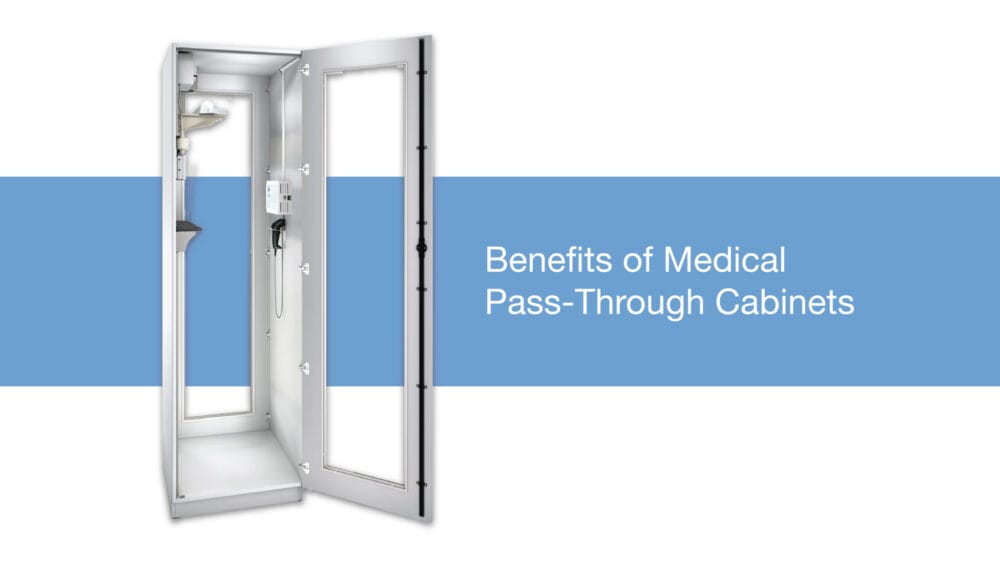
What Is a Medical Pass-Through Cabinet?
Pass-through cabinets are installed in a wall between two areas or rooms. Medical pass-through cabinets have a door on both sides to allow staff access to the cabinet from inside and outside the room.
This article examines where medical pass-through cabinets are used and how they can positively impact patient safety and staff workflows.
What Medical Areas Would Benefit From Pass-Through Cabinets?
The Centers for Disease Control and Prevention reports that the three ingredients needed to transmit pathogens are:
- A person or object harboring the pathogen (source)
- A person susceptible to that pathogen (host)
- A method of transmission (source to host)
Eliminating or reducing transmission routes of infectious pathogens is one way to reduce healthcare-acquired infections (HAIs). This is especially important in patient care areas, such as hospital, operating, and procedure rooms.
Patient Rooms
Installing medical pass-through cabinets between the patient’s room and the hallway allows staff to restock supplies from outside the patient’s room, reducing the number of people that enter the room and eliminating the transmission of pathogens.
Laboratory Areas
Pass-through medical cabinets have long been used in laboratories and sample testing areas of provider offices, providing an extra measure of safety when handling urine or other patient samples.
Patients or healthcare workers can place samples inside the cabinet without transporting potentially pathogenic containers from one area to another. The staff member on the other side retrieves the sample from inside the lab area. This can reduce the risk of spills, contamination, or accidental drop off of samples to the wrong location or a clean area.
Operating Rooms
A study published in Cambridge Core found that increased staff movement in the OR was associated with a higher microbial load. Installing pass-through cabinets in high-risk areas, such as the OR and clean procedure rooms, may help to reduce the transmission of pathogens in high-traffic areas.
Endoscopy Units
An article published in the journal Clinical Gastrointestinal Endoscopy recommends that endoscopes be stored in areas accessed only when necessary to reduce the risk of contamination.
Installing pass-through scope storage cabinets between the final clean reprocessing room and the endoscopy clean room reduces the need for staff to transport reprocessed scopes out of a clean area, through areas where the scope could become contaminated, and then into a clean procedure room.
Lockable pass-through cabinets further prevent unauthorized access and potential contamination.
The Association for the Advancement of Medical Instrumentation (AAMI) and the Society of Gastroenterology Nurses and Associates, Inc. (SGNA) recommend endoscopes be stored in conventional scope cabinets or drying cabinets that use pressurized HEPA-filtered air throughout the cabinet. HEPA-filtered air may also be forced through the endoscope channels to ensure adequate drying.
If moisture is left in or on a scope, even one remaining pathogen can proliferate into large colonies. Infectious outbreaks have been traced back to endoscopes that were not completely dry before patient use, as reported in The Lancet Gastroenterology & Hepatology.
Pass-through scope cabinets can be equipped as conventional cabinets, or drying cabinets that introduce pressurized HEPA-filtered air throughout the cabinet and individual scope channels.
After the required drying time, scopes are ready to be removed from the other side of the pass-through cabinet, ideally located in the clean workroom next to the procedure rooms.
Scope Monitoring Provides Enhanced Safety….And It’s Best Practice
The SGNA recommends each facility track key data throughout the scope’s life cycle, including:
- The technician responsible for each reprocessing step
- Procedure name and date
- Provider
- Patient identifier
This information helps investigators to trace a scope’s movements in the event of an infectious outbreak.
The InnerSpace Cloud system allows staff to monitor drying and track scope storage locations. InnerSpace Cloud will notify you when scopes are expired and disposable tubes and filters need to be replaced.
Pass-through medical cabinets are a tool in the healthcare manager’s toolbox, providing an additional layer of safety while improving staff efficiency. Contact InnerSpace for more information about their Ventaire Endoscopy System, including scope drying and tracking pass-through cabinets and Cloud monitoring platform.

Cindy Blye
Content WriterCindy Blye, BSN, RN, CCM is a Registered Nurse and Certified Case Manager. She is an Alumni of West Virginia University School of Nursing (BSN), and a member of the Association of Health Care Journalists and The Authors Guild.
